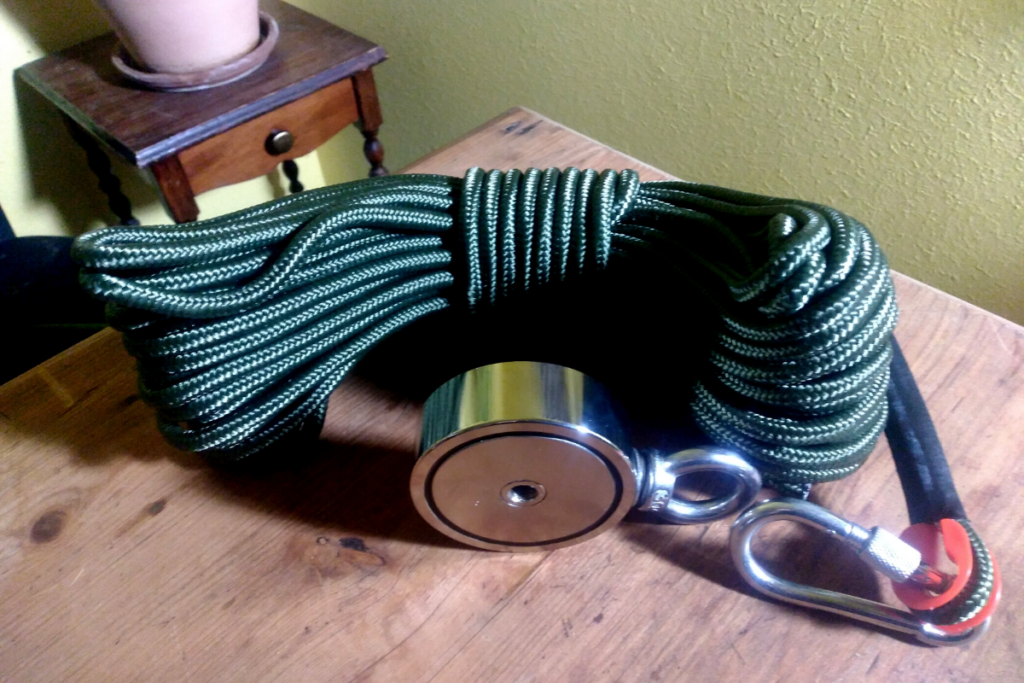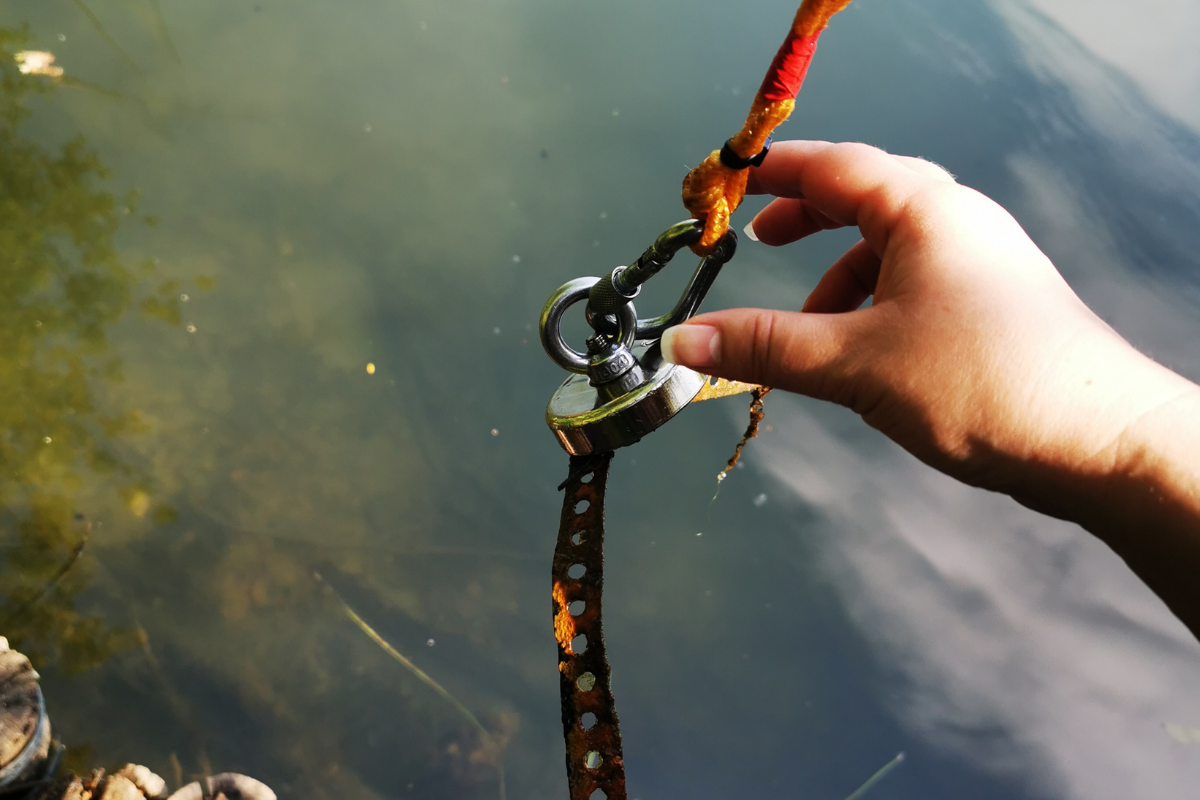Magnet fishing is an exciting new hobby, that many people around the world are getting into. This hobby has nothing to do with catching fish, and everything to do with catching treasures and odd items! We’re going to show you exactly how-to magnet fish, step by step. So, let’s DIVE in!
How to Magnet Fish
To magnet fish, you need a strong magnet and a tough rope. You are going to cast your magnet from the shore, or the top of a bridge, and other locations, into bodies of water. The magnet will attach to metal objects such as coins, and old relics. You will then pull up the magnet to analyze your catch.
This is such a fun hobby. You can find all kinds of treasure below the water’s surface. There are some rules you will need to follow, and some best practices. But first, you will need to make sure that it is legal in your state or your local area. For a basic understanding of magnet, fishing see our article for what is magnet fishing.
Are You Allowed to Magnet Fish?
First off, we need to talk about if magnet fishing is allowed where you live. In the U.S. there is no federal law regulating magnet fishing, however, there are state and local rules that you will have to research on a local level. To my knowledge, South Carolina is the only state that prohibits magnet fishing in public waterways on a state level. Source.
The laws are tricky when it comes to magnet fishing, treasure hunting, metal detecting, and the like. You must follow archeology rules and guidelines. This means that you could get into trouble if you disturb something like an undiscovered shipwreck, by pulling it apart with a magnet.
Some laws and rules can affect what you find. For instance, if you find a gun or a knife, you must call the police. This is because the weapons could have been used in a crime. The last thing you want to do is get your fingerprints on a weapon that hurt someone.
The same goes for things that could have been stolen, such as a safe dumped in a river, or a lockbox. These things must be reported. Some places, like state parks, may require a permit for magnet fishing. Source.
What You Need to Magnet Fish
When magnet fishing you’re going to need several items, to comprise your magnet fishing setup. With the magnets, you may want to have more than one, and more than one size.
The essentials for magnet fishing:
- Magnets
- Rope
- Gloves
For the magnets, you’re going to need neodymium fishing magnets, with an eye bolt. They can be anywhere from 600-pound magnets up to around 2,600 pounds. You may want to consider having 2 or three of them with different weights, so you can lift different weighted items.
It also helps to have two, because one might get stuck, and it may take a second stronger magnet to retrieve the first one. It also helps to have more than one rope in case one of them breaks. A grappling hook can also help retrieve stuck items and pull up other large items.
The gloves are an essential part of magnet fishing. You will need a pair of cut-proof gloves since you will be handling sharp pieces of metal. These will also keep you from getting rope burn if you lose your grip and the rope slides from your hands.

How to Set up for Magnet Fishing
Once you have your gear and are ready to get started magnet fishing, there are a few things you should know for setting up for magnet fishing. You will want to start by researching places to go magnet fishing. You will need to have permission if you are doing it on private property.
Next, you will want to set up a designated area to attach the rope and get everything ready. You want your preparation area to be free of any pieces of metal, or any electronics. You will also want something to carry your gear inside of. I have a backpack to carry my setup. Some people use plastic cases.
Some ropes have carabiners attached to them, which makes it super easy to attach to the eyehook on the magnet. If not, you will need to tie a good knot that will hold up to the heavy weight that you will be lifting. A Palomar knot is a good example of a strong knot.
Magnet Fishing Step by Step
Now for the fun part. Once you have all of your gear, and you have found the area where you plan on doing your magnet fishing, you are ready to get started. Here is our step-by-step guide on how to magnet fish.
Step 1
Explore the area where you are doing your magnet fishing. You will find that it may be easier to go from the top of a bridge, or the side of the river. Look for the most strategic point. You want to have a good foot stance when you cast your magnet.
Step 2
Now you are ready to cast your magnet. Make sure there is not another person close to you, that you could hit with the magnet while casting. Some people just drop the magnet, while others will cast it out, like with traditional fishing. I prefer to either drop it or swing it out. Also, tie your rope off, so you don’t lose it.
Step 3
Once you have cast it out, slowly drag the magnet in towards you. If you are on a shore you can walk the shore while dragging the magnet, this helps cover more ground. Go slow, so that the magnet has time to lock onto something.
Step 4
Once you have locked onto an item, start to pull it up. If it is very heavy, having a second person can be useful. If you are on the shore, you can drag it to shore, but be careful not to damage plants or wildlife. If you are above the water, you will need to pull it up.
Step 5
Now that you have pulled up your item, you will want to inspect it. If you have found something that is illegal, or something you think could have been stolen and dumped, you will need to contact the authorities. You have the chance to pull up relics, random metal, and more.
Step 6
If you have pulled up random metal, or something that you do not want to keep, you will still need to take it home and dispose of it. Do not throw anything that is trash back into the water. This not only helps you find scraps of metal that can be kept to cash in at a scrap metal yard, but it also helps clean up the water!
How Strong of a Magnet do You Need?
There are all types of weight ratings when it comes to fishing magnets. A lot of magnets may be rated high, but do not perform that well. I suggest using a magnet that someone who actually magnet fishes, has used and reviewed.
There are smaller magnets that start at 150 pounds to 350 pounds. As long as the magnet is high-quality, it should be fine for getting most items. If you need something stronger, a 600+ magnet is going to be your best bet. As I have mentioned before, I suggest getting more than one size of magnet.
Types of Ropes
The rope you will be using will need to be a strong rope that is rated to be used with the weights you will be pulling up. I suggest using a polypropylene rope since it doesn’t soak up water. You can also use nylon ropes, paracord ropes, and more.
You want the rope to be around 30-50 feet long. You can use longer ropes if you are fishing a larger area, but keep in mind, it’s that much more you have to pull in when recovering an item.
For the shore or marsh areas, a shorter rope (30-50’) will do. If you are casting from a bridge you may want to use a longer rope, around 100 ft. You need the rope to be high-quality since you will be putting it in and out of water frequently. As mentioned before we suggest having multiple ropes.
Magnet Fishing Finds
Now that you know how to magnet fish, you may be wondering what types of items you may find. Here is a quick list of relics and other things you may pull up from your adventures.
- Jewelry
- Weapons
- Scrap metal
- Bicycles
- Artifacts
- Bolts
- Tools
There is really no limit to the number of things you can find. I’ve personally found old tools, bike pieces, doorknobs, and more. Remember that if you find any weapons, anything illegal, or something that might be stolen, contact the authorities, and try not to touch them with your bare hands. See our article for – is magnet fishing worth it here.
Things that get reported can be returned to you if they are cleared of any criminal activity.
The man who attracts luck carries with him the magnet of preparation.
Clifton Fadiman
Conclusion
Magnet fishing is an awesome hobby that has a lot of benefits. You clean up the waterways, and you learn about artifacts by researching the items you find. On top of that, you get some good exercise!
Always be as safe as possible, you may want to bring hand sanitizer with you for cleaning your hands, and if you find something dangerous, do not mess with it, call in an authority to help you dispose of it or clear it of criminal activity. Now get out there and start hunting for that treasure!

